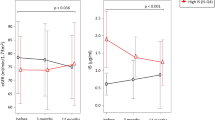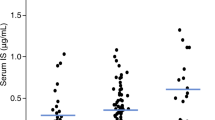Abstract
Background
Few studies have examined whether catheter ablation for AF patients improves biomarkers other than serum levels of brain natriuretic peptide (BNP) and renal function. This study was to explore whether catheter ablation for atrial fibrillation (AF) patients affects uric acid (UA), glucose and lipid metabolism.
Methods and results
A total of 206 patients (66.6 ± 10.4 years; 132 men) who underwent initial AF ablation without changes to oral medications were included. Baseline BNP and UA levels significantly decreased at 1 year after ablation (p < 0.05 each). Changes in UA level correlated significantly with pre-procedural UA level (r = 0.57). In multivariable logistic regression modeling, pre-procedural UA level, persistent AF, and hemoglobin A1c (p < 0.05 each) were independent predictors of post-procedural UA level decline. Significant improvements in both persistent and paroxysmal AF patients were identified, and the magnitude of post-procedural serum UA level decline after ablation (ΔUA) was significantly greater in patients with persistent AF (0.8 ± 1.0 mg/dl) than in those with paroxysmal AF (0.2 ± 0.8 mg/dl, p < 0.001). Of the 48 patients with high UA level before procedure, 28 patients showed improvement in UA level to normal range.
Conclusions
Catheter ablation for AF patients significantly improved serum UA levels without obvious influences of heart failure, renal function, or inflammation, suggesting that AF ablation may be effective for AF patients with hyperuricemia.
Trial registration The study was approved by the Research Ethics Committee of University of Fukui (no. 20210132) and clinical trial registration (UMIN000044669).


Similar content being viewed by others
Abbreviations
- ACEI:
-
Angiotensin-converting-enzyme inhibitor
- AF:
-
Atrial fibrillation
- ARB:
-
Angiotensin 2 receptor blocker
- BNP:
-
Brain natriuretic peptide
- CFAEs:
-
Continuous fractionated atrial electrograms
- CI:
-
Confidence interval
- hs-CRP:
-
High-sensitivity C-reactive protein
- eGFR:
-
Estimated glomerular filtration rate
- HbA1c:
-
Hemoglobin A1c
- HDL-cholesterol:
-
High-density lipoprotein cholesterol
- LDL-cholesterol:
-
Low-density lipoprotein cholesterol
- LV:
-
Left ventricular
- LVEF:
-
Left ventricular ejection fraction
- OR:
-
Odds ratio
- PV:
-
Pulmonary vein
- UA:
-
Uric acid
- XO:
-
Xanthine oxidase
References
Di Biase L, Mohanty P, Mohanty S, Santangeli P, Trivedi C, Lakkireddy D, Reddy M, Jais P, Themistoclakis S, Dello Russo A, Casella M, Pelargonio G, Narducci ML, Schweikert R, Neuzil P, Sanchez J, Horton R, Beheiry S, Hongo R, Hao S, Rossillo A, Forleo G, Tondo C, Burkhardt JD, Haissaguerre M, Natale, (2016) Ablation versus amiodarone for treatment of persistent atrial fibrillation in patients with congestive heart failure and an implanted device: results from the AATAC multicenter randomized trial. Circulation 133:1637–1644
Nogami A, Kurita T, Abe H, Ando K, Ishikawa T, Imai K, Usui A, Okishige K, Kusano K, Kumagai K, Goya M, Kobayashi Y, Shimizu A, Shimizu W, Shoda M, Sumitomo N, Seo Y, Takahashi A, Tada H, Naito S, Nakazato Y, Nishimura T, Nitta T, Niwano S, Hagiwara N, Murakawa Y, Yamane T, Aiba T, Inoue K, Iwasaki Y, Inden Y, Uno K, Ogano M, Kimura M, Sakamoto S, Sasaki S, Satomi K, Shiga T, Suzuki T, Sekiguchi Y, Soejima K, Takagi M, Chinushi M, Nishi N, Noda T, Hachiya H, Mitsuno M, Mitsuhashi T, Miyauchi Y, Miyazaki A, Morimoto T, Yamasaki H, Aizawa Y, Ohe T, Kimura T, Tanemoto K, Tsutsui H, Mitamura H (2021) JCS/JHRS 2019 guideline on non-pharmacotheraopy of cardiac arrhythmias. Cric J 85:1104–1244
Friberg L, Tabrizi F, Englund A (2016) Catheter ablation for atrial fibrillation is associated with lower incidence of stroke and death: data from Swedish health registries. Eur Heart J 37:2478–2487
Yamada T, Murakami Y, Okada T, Yoshida N, Toyama J, Yoshida Y, Tsuboi N, Inden Y, Hirai M, Murohara T (2007) Plasma brain natriuretic peptide level after radiofrequency catheter ablation of paroxysimal persistent, and permanent atrial fibrillation. Europace 9(9):770–774
Takahashi Y, Takahasi A, Kuwahara T, Okubo K, Fujino T, Takagi K, Nakashima E, Kamiishi T, Hikita H, Hirao K, Isobe M (2011) Renal function after catheter ablation of atrial fibrillation. Circulation 124(22):2380–2387
Nagahama K, Iseki K, Inoue T, Touma T, Ikemiya Y, Takishita S (2004) Hyperuricemia and cardiovascular risk factor clustering in a screened cohort in Okinawa. Japan Hypertens Res 27(4):227–233
Li S, Cheng J, Cui L, Gurol ME, Bhatt DL, Fonarow GC, Benjamin EJ, Xing A, Xia Y, Wu S, Gao X (2019) Cohort study of repeated measurenments of serum urate and risk of incidence atrial fibrillation. J Am Heart Assoc 8(13):e012020
Liu Z, Que S, Zhou L, Zheng S (2015) Dose-serponse relationship of serum uric acid with metabolic syndrome and non-alcohlic fatty liver disease incidence: a meta-anaysis of prospective study. Sci Rep 5:14325
Zhao J, Liu T, Korantzopoulos P, Letsas KP, Zhang E, Yang Y, Zhang Z, Qui J, Li J, Li G (2016) Association between serum uric acid and atrial fibrillation recurrence following catheter ablation: a meta-analysis. Int J Cardiol 204:103–105
Gou X, Zhang S, Yan X, Chen Y, Yu R, Long D, Sang C, Du X, Dong J, Ma C (2014) Postablation neutrophil/lymphocyte ratio correlates with arrhythmia recurrence after catheter ablation of lone atrial fibrillation. Chin Med J (Engl) 127(6):1033–1038
Maharani N, Ting YK, Cheng J, Hasegwa A, Kurata Y, Li P, Nakayama Y, Ninomiya H, Ikeda N, Morikawa K, Yamamoto K, Makita N, Yamashita T, Shirayoshi Y, Hisatome I (2015) Molecular mechanisms underlying urate-induced enhancement of Kv1.5 channel expression in HL-1 atrial myocytes. Circ J 79(12):2659–2668
Doehner W, Landmesse U (2011) Xanthine oxidase and uric acid in cardiovascular disesase: clinical impact and therapeutic options. Semin Nephrol 31(5):433–440
CarnesChungNakayamaNakayamaBaligaPiaoKanderianPavia CAMKTHRSSAS, HamlinMcCarthy BauerVamWagoner RLPMJADR (2001) Ascorbate attenuates atrial pacing-induced perroxynitrite formation and electrical remodeling and decreases the incidence of postoperateci atrial fibrillation. Circ Res 89(6):E32–E38
Gonzalez RD, Treuer A, Sun QA, Stamler JS, Hare JM (2009) S-Nitrosylation of caradiac ion channels. J Cardiovasc Phamacol 54(3):188–195
Ono K (2019) How is uric acid related to atrial fibrillation? Circ J 83(4):705–706
Shoji A, Yamanaka H, Kamatani N (2004) A retrospective study of the relationship between serum urate level and recurrent attacks of gouty arthritis: evidence for reducrtion of recurrent gouty arthritis with antihyperuricemic therapy. Arthritis Rheum 51(3):321–325
Ndrepepa G, Braun S, Hasse HU, Schulz S, Ranftl S, Hadamitzky M, Mehilli J, Schömig A, Kastrati A (2012) Prognostic value of uric acid in patients with acute coronary syndromes. Am J Cardiol 109(9):1260–1265
Shibata Y, Shirakabe A, Okazaki H, Matsushita M, Goda H, Shigihara S, Asano K, Kiuchi K, Tani K, Murase T, Nakamura T, Kobayashi N, Hata N, Asai K, Shimizu W (2020) Plasma xanthine oxidoreductase (XOR) activity in patients who require cardiovascular intensive care. Heart Vessels 35(10):1390–1400
Nishino M, Mori N, Yoshimura T, Nakamura D, Lee Y, Taniike M, Makino N, Kato H, Egami Y, Shutta R, Tanouchi J, Yamada Y (2014) Higher serum uric acid and lipoprotein(a) are correlated with coronary spasm. Heart Vessels 29(2):186–190
Seki H, Kaneko H, Morita H, Itoh H, Morita K, Matsuoka S, Kiriyama H, Kamon T, Fujiu K, Michihata N, Jo T, Takeda N, Yano Y, Nakamura S, Node K, Yasunaga H, Komuro I (2021) Relation of serum uric acid and cardiovascular events in young adults aged 20–49 years. Am J Cardiol 152:150–157
Kawashima M, Wada K, Ohta H, Terawaki H, Aizawa Y (2011) Association between asymptomatic hyperuricemia and new-onset chronic kidney disease in Japanese male workers: a long-term retrospective cohort study. BMC Nephrol 12:31
Thanassoulis G, Brophy JM, Richard H, Pilote L (2010) Gout, allopurinol use, and heart failure outcomes. Arch Intern Med 170(15):1358–1364
Funding
Daiichi Sankyo Company,Biotronik,Bristol-Myers Squibb,Boehringer Ingelheim,Bayer,ALVAUS,Novartis Pharma,Ono Pharmaceutical,Takeda Pharmaceutical Company,DVx.
Author information
Authors and Affiliations
Corresponding author
Ethics declarations
Conflicts of interest
Hiroshi Tada is a member of Circulation Journal’s editorial team and received honoraria (lecture fees) from Daiichi-Sankyo Co., Ltd., Biotronik Japan, Inc., Bristol-Myers Squibb, and Boehringer Ingelheim and grants from Bayer Yakuhin, Ltd., Japan, Boehringer Ingelheim Japan, ALVAUS Co., Ltd., Novartis Pharmaceuticals Japan, ONO PHARMACEUTICAL CO., LTD, and Takeda Pharmaceutical Company, Ltd. Daisetsu Aoyama, Moe Mukai, and Shota Kakehashi belong to endowed department by Biotronik Japan, Inc., DVx Inc., ALVAUS Co., Ltd. No other authors have any conflicts of interest to disclose.
Additional information
Publisher's Note
Springer Nature remains neutral with regard to jurisdictional claims in published maps and institutional affiliations.
Rights and permissions
About this article
Cite this article
Aoyama, D., Uzui, H., Sekihara, T. et al. Declines in serum uric acid level after catheter ablation of atrial fibrillation. Heart Vessels 37, 2049–2058 (2022). https://doi.org/10.1007/s00380-022-02108-w
Received:
Accepted:
Published:
Issue Date:
DOI: https://doi.org/10.1007/s00380-022-02108-w




